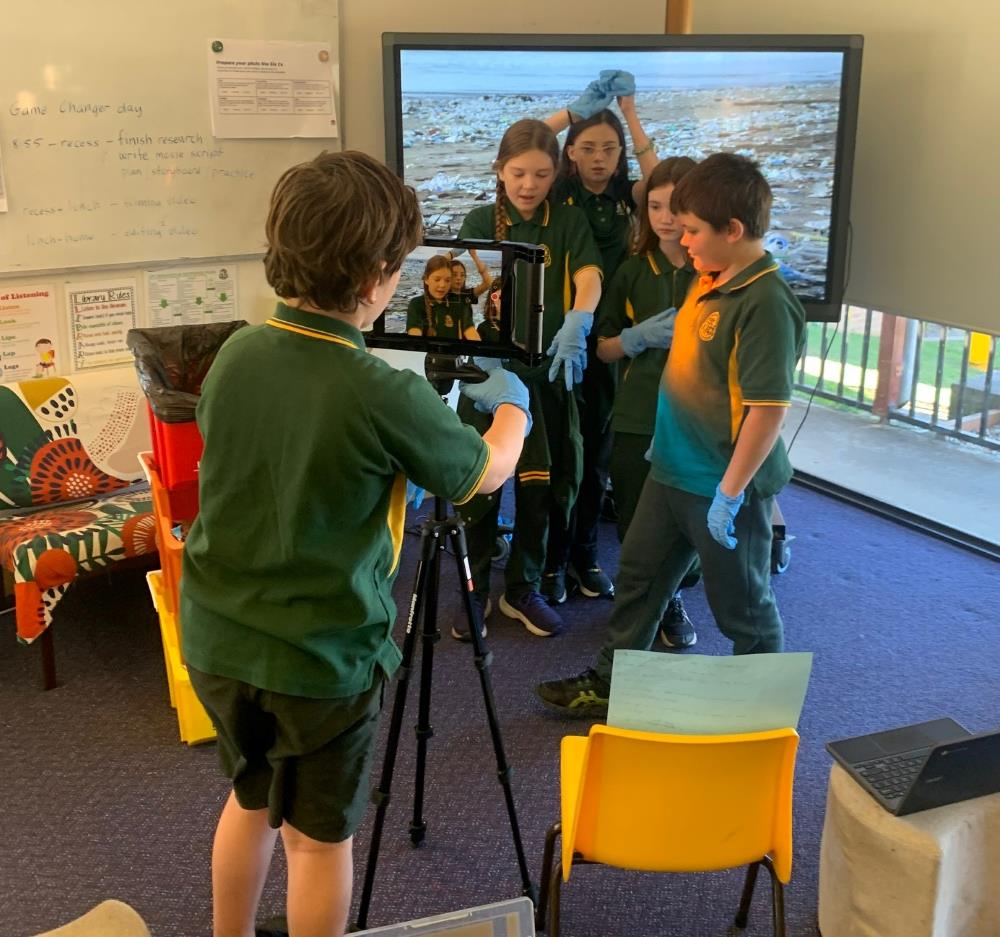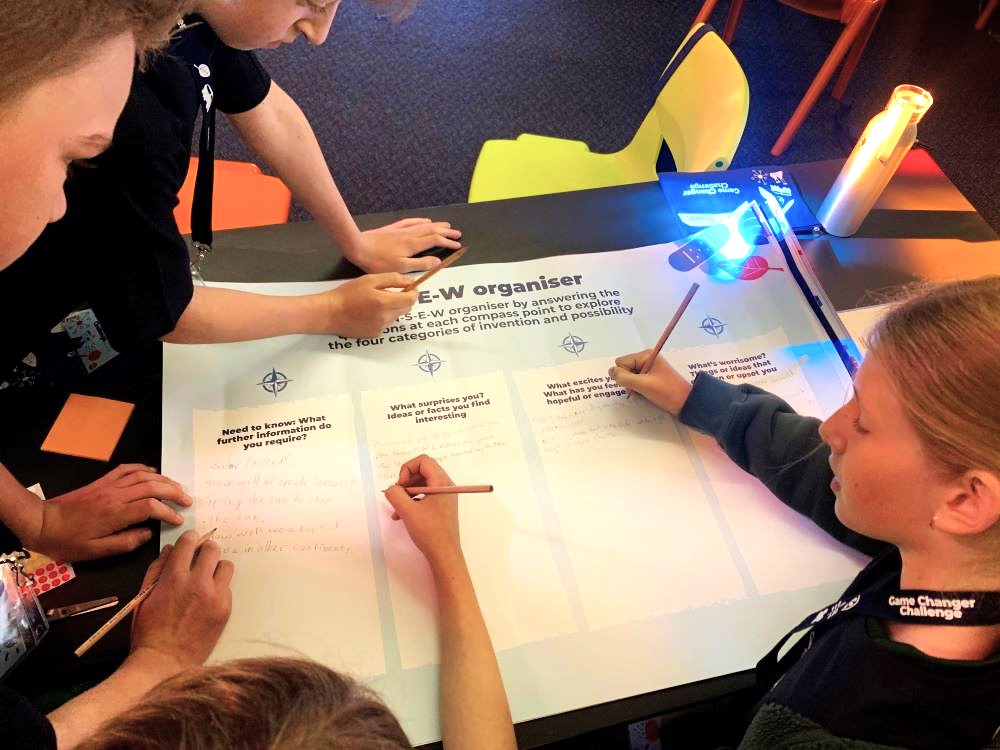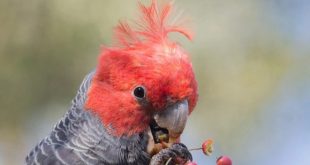
‘Extinction Experts’: Oliver, Leo and Timothy with teacher Jane Truswell (not pictured: Archer and Wren)
Story by Liz Durnan
When school kids around the state heard the call: Invent or innovate something that will change our world and leave a lasting impact, Lawson Public School students rose to the challenge.
The day I visit Lawson Public School, the children gathered in the library are buzzing with excitement. They’re fresh from taking part in this year’s Game Changer Challenge, with two of the three teams making it to the semi-finals.
Key Points:
- The Game Changer Challenge is an annual event by the NSW Department of Education
- In 2023 students were challenged to ‘invent or innovate something that will change our world and leave a lasting impact’
- Lawson Public School took up the challenge in 2023 with impressive results
In the annual Game Changer Challenge, the NSW Department of Education sets a ‘Wicked Problem’ for primary and secondary schools around the state. This ‘design thinking competition’ encourages students to discover real-world solutions to real-world problems.
The three teams have devised their own names – Einstein’s Minions (years 5 & 6) are addressing the issue of bushfires; The Extinction Experts (years 3 & 4) look at species loss in the Blue Mountains; and The Revolution Ducks (years 4, 5 & 6) tackle the problem of littering.

Team ‘Revolution Ducks’: Devendra, Lachlan, Talara and Luella with teacher Jane Truswell (not pictured: Sadie)
According to Learning & Support Teacher Jane Truswell, the Game Changer Challenge inspires the students to think carefully about practical ways they can make an impact.
“It has given them a sense of agency to face the world’s problems,” Jane says. “If they want to talk to somebody in the field, they can interview an ecologist or they can talk to people from different services and find out more.
This is not something they’ve done before, so it’s really helped connect their learning with things they can change in the world. – Jane Truswell, Learning & Support Teacher
Relieving Principal Hayley Cross agrees: “Because the students went out to survey people for their research, the Challenge provided amazing learning opportunities. They were able to tap into a whole other world of learning that allows this out-of-the-box thinking.”
Once each group identified a problem to tackle, they invented their solution and designed a prototype. According to Jane, this design process helped students engage with the reality of the problem.
Each group then filmed a two-minute video outlining the solution and the process.

Team ‘Einstein’s Minions’: Harry, Rhys and Seren ( Not pictured: Alby and Mytchell)
I watch these videos with genuine interest, impressed at the innovative ideas conceived by these students. They are only between 8 and 11 years of age.
Team Extinction Experts
The Extinction Experts looked at animals that are vulnerable to extinction, and focused specifically on threats faced by local species such as the Blue Mountains Water Skink and the Eastern Pygmy Possum.
After finding out more about these creatures, the group proposed an invention they called ‘the hideaway tube’ – a weatherproof retreat space the animal could hide in to cope with extreme events.
As part of their research, the students spoke to Julie Favell from the Lithgow Environment Group, learning about post-bushfire research on homes for Pygmy Possums and how people have reused pipes to create homes for the animals.
Team Revolution Ducks
Meanwhile, The Revolution Ducks focused on the impact of littering, examining rubbish sorting and waste minimisation initiatives at Lawson.

The Revolution Ducks team work on their video submission
Their idea was to make this waste more sortable with the invention of a wearable backpack designed specifically for waste: complete with sections for people to sort their waste on the go.
Team Einstein’s Minions
The third team, Einstein’s Minions, investigated bushfires and conceived a complex solution involving temperature sensors and sprinklers that would react to temperatures, cooling down surfaces in the event of bushfire. For this, they extensively researched backburning and the ways it’s used to fight bushfires.
In each case, the problem focuses on an issue that directly affects their local community. The students surveyed their peers extensively, then their wider community, to discover the things that impact them, and what they worry about.
They also found their solutions within that community, mostly from experts with local knowledge.
It’s even more impressive to learn that the children came up with many of the ideas independently, with only a little help and encouragement from Jane.
Design Thinking
Along with playbooks provided by the Department of Education to teach design thinking strategies, the teams worked together to use research to find solutions.
For anyone wondering what ‘design thinking’ means, the Department of Education’s Game Changer website explains:
- Design thinking is a human-centred process to solving complex problems.
- Empathy and collaboration are at the heart of design thinking.
- The five-step process starts by encouraging problem solvers to walk in the shoes of those experiencing the ‘problem’ to gain a deeper insight into the challenges and issues they face (empathy).
- This knowledge is then used to develop a clear problem statement (define), work on solutions (ideate), turn these solutions into tangible products (prototype) and then see whether the solution will work (test).
When I talk to the students about their ideas, their enthusiasm is palpable. I hear how they’re directly affected by the issues they address, such as bushfires, and how closely some have been personally impacted by them.
“We had loads of ideas actually,” Harry from Einstein’s Minions tells me. “And I don’t know how we decided on bushfires. It’s something you think about quite a bit.”
While they all agree the project was ‘lots of fun’, they’re candid about the difficulties at times. They articulated one of the most important life lessons: you make mistakes, fail and repeat the process until you get it.
Making the video was another key learning experience, also completed with minimal help from teachers who mainly provided guidance on using the technology and script storyboarding.

The Einstein’s Minion’s team participate in a semi-final brainstorming session.
This all fostered a collaborative supportive approach among the children with the teams helping each other out despite them being up against each other in the competition.
According to Hayley, the roles each student took on within the group enhanced not only the learning process, but also their social skills.
“They had to work as a team, even though many of the academically bright kids can be very solo,” Hayley says.
“This was challenging at first because they had to look at their skills: some might be communicators; some might have emerging leadership skills. They didn’t always get the role they wanted but they took it maturely and worked together.
“And they completed the project, which doesn’t always happen because they’re interested in lots of new things. But here, we had a deadline to stick to, so it really allowed us to do that full circle.”
She is equally proud of all the teams and embraced the idea of the Game Changer Challenge when presented by Jane.

The Extinction Experts team work on large design canvases during the semi final
For Jane, discovering solutions empowered the students to make sense of the world.
The Game Changer Challenge is very much around listening to what kids would like and how they’d like to make the world a better place. – Jane Truswell
Hayley agrees. “Sometimes people say, ‘Oh, you’re just kids’. But kids make a huge difference. And it starts there, doesn’t it?”
120 teams took part in the virtual semi-finals of the Game Changer Challenge, held in Week Six and Seven of Term Three.
Take Action:
- To involve your school in 2024 visit https://education.nsw.gov.au/public-schools/game-changer-challenge
- Learn about design thinking in NSW schools: https://education.nsw.gov.au/public-schools/game-changer-challenge/teacher-information
- Share this story with students and teachers in your community to help more schools take up the challenge!
Share this article:
This story has been produced as part of a Bioregional Collaboration for Planetary Health and is supported by the Disaster Risk Reduction Fund (DRRF). The DRRF is jointly funded by the Australian and New South Wales governments.

















